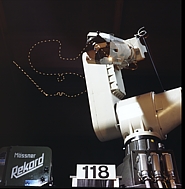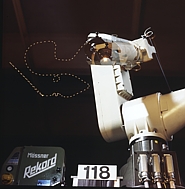

| Stereo Motography |
By photographically recording light patterns emitted from a flashing light source, changes in space and time can be tracked and evaluated. The method is called Stereo Motography (when using two cameras to record the scene) and is useful in clinical practice and research.
Obviously, the recording takes place inside a darkened room, so the flashing light can leave a trace of dots on the film. One flash image at the end of this procedure records the moving object itself to bring the light curve into a context with the subject or object to be analyzed.
The obtained data can be analyzed by describing pictures (qualitative analysis) as well as by quantitative measurements from the light pattern curves (photogrammetric measurement).
Applications of Stereo motography include Ergonomics (for example to check repetitive movements of a supermarket cashier and to optimize the checkout procedure), or robotics (to fine-tune three-dimensional movements). See the example below.
|
|
|
|
||
 |
 |
 |
||
|
||||
| Stereo Motography used to analyze movements of a Robot | ||||
 |
|

| Back to the Stereoscopy.com FAQ Page |
